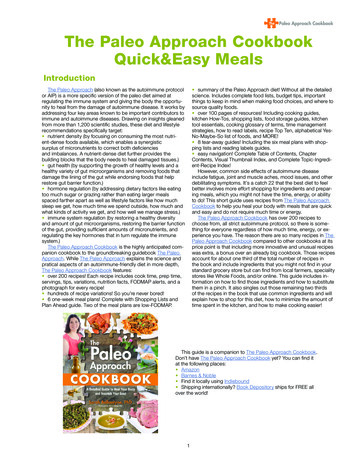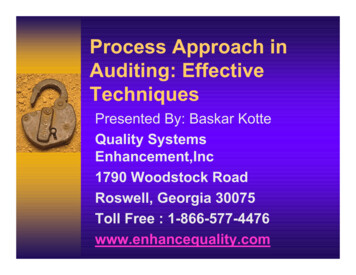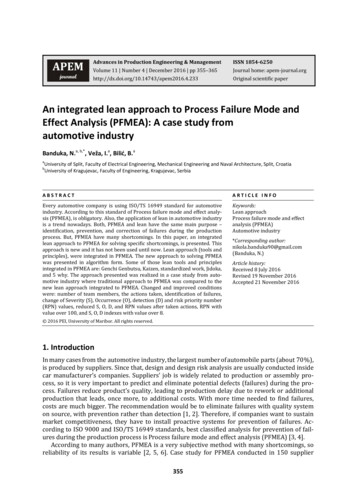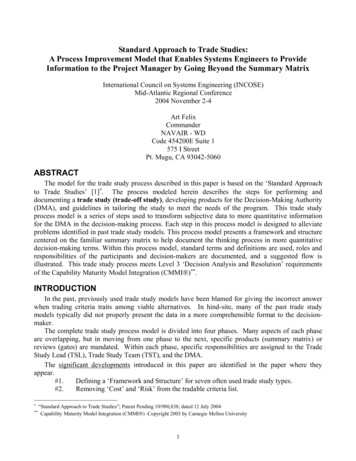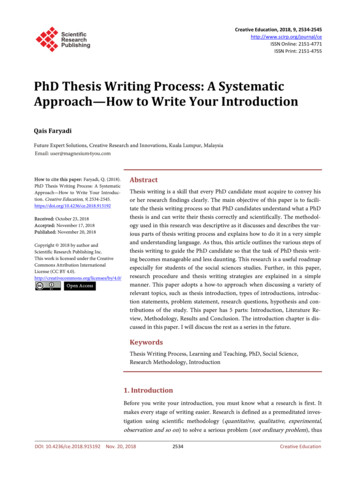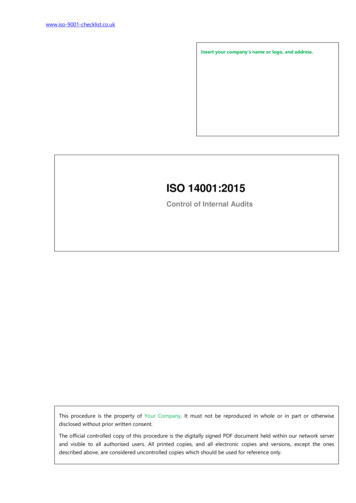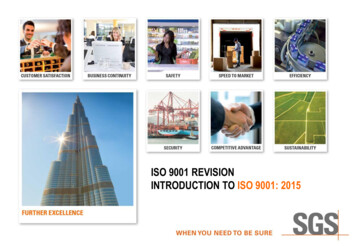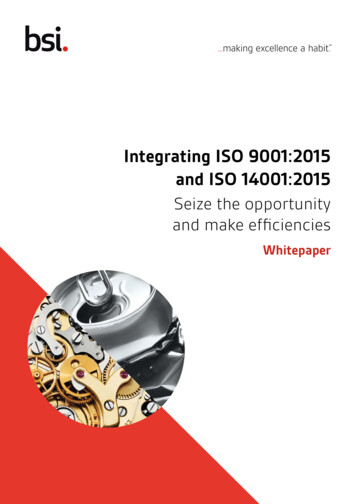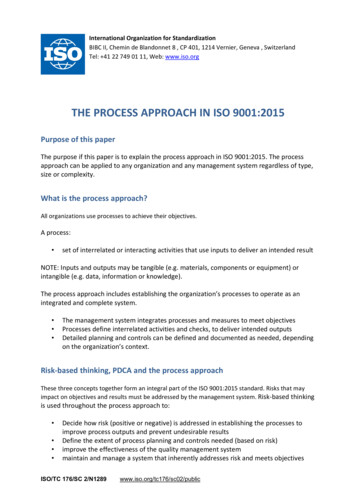
Transcription
International Organization for StandardizationBIBC II, Chemin de Blandonnet 8 , CP 401, 1214 Vernier, Geneva , SwitzerlandTel: 41 22 749 01 11, Web: www.iso.orgTHE PROCESS APPROACH IN ISO 9001:2015Purpose of this paperThe purpose if this paper is to explain the process approach in ISO 9001:2015. The processapproach can be applied to any organization and any management system regardless of type,size or complexity.What is the process approach?All organizations use processes to achieve their objectives.A process: set of interrelated or interacting activities that use inputs to deliver an intended resultNOTE: Inputs and outputs may be tangible (e.g. materials, components or equipment) orintangible (e.g. data, information or knowledge).The process approach includes establishing the organization’s processes to operate as anintegrated and complete system. The management system integrates processes and measures to meet objectives Processes define interrelated activities and checks, to deliver intended outputs Detailed planning and controls can be defined and documented as needed, dependingon the organization’s context.Risk‐based thinking, PDCA and the process approachThese three concepts together form an integral part of the ISO 9001:2015 standard. Risks that mayimpact on objectives and results must be addressed by the management system. Risk‐based thinkingis used throughout the process approach to: Decide how risk (positive or negative) is addressed in establishing the processes toimprove process outputs and prevent undesirable results Define the extent of process planning and controls needed (based on risk) improve the effectiveness of the quality management system maintain and manage a system that inherently addresses risk and meets objectivesISO/TC 176/SC 2/N1289www.iso.org/tc176/sc02/public
PDCA is a tool that can be used to manage processes and systems. PDCA stands for:P Plan: set the objectives of the system and processes to deliver results (“What to do”and “how to do it”)D Do: implement and control what was plannedC Check: monitor and measure processes and results against policies, objectives andrequirements and report resultsA Act: take actions to improve the performance of processesPDCA operates as a cycle of continual improvement, with risk‐based thinking at each stage.What are the possible benefits? A focus on the more important (“high‐risk”) processes and their outputs improved understanding, definition and integration of interdependent processes systematic management of planning, implementation, checks and improvement ofprocesses and the management system as a whole. better use of resources and increased accountability more consistent achievement of the policies and objectives, intended results andoverall performance process approach can facilitate the implementation of any management system enhanced customer satisfaction by meeting customer requirements enhanced confidence in the organization.The practical steps in using a process approach in ISO 9001:2015 are explained below inAppendix A.Other useful documentsISO 9001:2015 The Process Approach(a power point presentation on www.io.org/tc176/sc02/public)ISO/TC 176/SC 2/N1289www.iso.org/tc176/sc02/public
Appendix AThe process approach in ISO 9001:2015In accordance with the requirements of ISO 9001 the following sequence of actions providesexamples of how an organization may choose to build and control the processes of its qualitymanagement system. Performance can be managed and improved by applying the Plan‐Do‐Check‐Act (PDCA) cycle. This applies equally to the system as a whole, to individual processes and tooperational activities.Steps in theprocessapproachWhat to do?GuidancePLANDefine thecontext of theorganizationThe organizationshould identify itsresponsibilities, therelevant interestedparties and theirrelevantrequirements, needsand expectations todefine theorganization’sintended purpose.Gather, analyze and determine external and internalresponsibilities of the organization to satisfy the relevantrequirements, needs and expectations of the relevantinterested parties. Monitor or communicate frequently withthese interested parties to ensure continual understandingof their requirements, needs and expectations.Define thescope,objectives andpolicies of theorganizationBased on the analysisof the requirements,needs andexpectationsestablish the scope,objectives andpolicies that arerelevant for theorganization’s qualitymanagement system.The organization shall determine the scope, boundaries andapplicability of its management system taking intoconsideration the internal and external context andinterested party requirements. Decide which markets theorganization should address. Top management should thenestablish objectives and policies for the desired outcomes.Determine theprocesses intheorganizationDetermine theprocesses needed tomeet the objectivesand policies and toproduce the intendedoutputs.Management shall determine the processes needed forachieving the intended outputs. These processes includemanagement, resources, operations, measurement, analysisand improvement.ISO/TC 176/SC 2/N1289www.iso.org/tc176/sc02/public
Determine thesequence ofthe processesDetermine how theprocesses flow insequence andinteraction.Define peopleor remits whotake processownership andaccountabilityAssign responsibilityand authority foreach process.Define and describe the network of processes and theirinteraction. Consider the following: The inputs and outputs of each process (which may beinternal or external). Process interaction and interfaces on which processesdepend or enable. Optimum effectiveness and efficiency of the sequence. Risks to the effectiveness of process interaction.Note: As an example, realization processes (such as thoseneeded to provide the products or services delivered to acustomer) will interact with other processes (such as themanagement, measurement, procurement in the provisionof resources).Process sequences and their interactions may be developedusing tools such as modeling, diagrams, matrices andflowcharts.Top Management should organize and define ownership,accountability, individual roles, responsibilities, workinggroups, remits, authority and ensure the competenceneeded for the effective definition, implementation,maintenance and improvement of each process and itsinteractions. Such individuals or remits are usually referredto as the Process Owners.To manage process interactions it may be useful to alsoestablish a management system team that has a systemoverview across all the processes and may includerepresentatives from the interacting processes andfunctions.ISO/TC 176/SC 2/N1289www.iso.org/tc176/sc02/public
Define theneed fordocumentedinformationDetermine thoseprocesses that needto be formallydefined and how theyare to bedocumented.Processes exist within the organization. They may be formalor informal. There is no catalogue or list of processes thathave to be formally defined. The organization shoulddetermine which processes need to be documented on thebasis of risk‐based thinking, including, for example: The size of the organization and its type of activities. The complexity of its processes and their interactions. The criticality of the processes. The need for formally accountability of performance.Processes can be formally documented using a number ofmethods such as graphical representations, user stories,written instructions, checklists, flow charts, visual media orelectronic methods including graphics and systemization.However, the method or the technology chosen are not thegoals. They can be used to describe processes, which are themeans to achieve the goals. Effective and organizedprocesses can then deliver consistent and accountableoperations and the desired objectives and results which canthen be improved.Note: For more guidance see the ISO 9000 Introduction andSupport Package module Guidance on the DocumentedInformation Requirements of ISO 9001:2015Define theinterfaces, risksand activitieswithin theprocessDetermine theactivities needed toachieve the intendedoutputs of theprocess and risks ofunintended outputs.Define the required outputs and inputs of the process.Determine the risks to conformity of products, services andcustomer satisfaction if unintended outputs are delivered.Determine the activities, measures and inherent controlsrequired to transform the inputs into the desired ouputs.Determine and define the sequence and interaction of theactivities within the process.Determine how each activity will be performed.Ensure that the management system as a whole takesaccount of all material risks to the organization and users.Note: In some cases the customer may specify requirementsnot only for the outputs but also for the realization of aprocess.Define themonitoring andmeasurementrequirementsDetermine where andhow monitoring andmeasuring should beapplied. This shouldbe both for controland improvement ofthe processes and theintended processoutputs.Determine the needfor recording results.Identify the validation necessary to assure effectiveness andefficiency of the processes and system. Take into accountsuch factors as: Monitoring and measuring criteria. Reviews of performance Interested parties’ satisfaction. Supplier performance. On time delivery and lead times. Failure rates and waste. Process costs. Incident frequency. Other measures of conformity with requirements.ISO/TC 176/SC 2/N1289www.iso.org/tc176/sc02/public
DOImplementImplement actionsnecessary to achieveplanned activities andresults.The organization should perform activities, monitoring,measures and controls of defined processes and procedures(which may be automated), outsourcing and other methodsnecessary to achieve planned results.Define theresourcesneededDetermine theresources needed forthe effectiveoperation of eachprocess.Examples of resources include: Human resources. Infrastructure. Environment. Information. Natural resources (including knowledge). Materials. Financial resources.CHECKVerify theprocess againstits plannedobjectivesConfirm that theprocess is effectiveand that thecharacteristics of theprocesses areconsistent with thepurpose of theorganization.ISO/TC 176/SC 2/N1289The organization should compare outputs against objectivesto verify that all the requirements are satisfied.Processes are needed to gather data. Examples includemeasurement, monitoring, reviews, audits and performanceanalysis.www.iso.org/tc176/sc02/public
ACTImprovementChange theprocesses to ensurethat they continue todeliver the intendedoutputsAct on the findings to ensure improvement of processeffectiveness. (NOTE: Organizations may also wish toimprove process efficiency, though it is not a requirement ofISO 9001 to do so).Corrective action as a result of process failure should includethe identification and elimination of the root causes of theproblems. ‘System Thinking’ recognizes that an event in oneprocess may have a cause or effect in a dependent process.Causes and the effects may not be within the same process.Problem solving and improvement typically follows theessential steps of: define the problems or objectivescollect and analyze the data on the problem andrelevant processesselect and implement the preferred solutionsevaluate the effectiveness of the solutions.incorporate the solutions into the routineEven when planned process outputs are being achieved andrequirements fulfilled, the organization should still seek toimprove process performance, customer satisfaction andreputation. This can be achieved, for example, by small‐stepcontinual improvement (“Kaizen”), breakthroughimprovements and/or by innovation.ISO/TC 176/SC 2/N1289www.iso.org/tc176/sc02/public
ISO/TC 176/SC 2/N1289 www.iso.org/tc176/sc02/public DO Implement Implement actions necessary to achieve planned activities and results. The organization should perform activities, monitoring, measures and controls of defined processes and procedures (which may be

